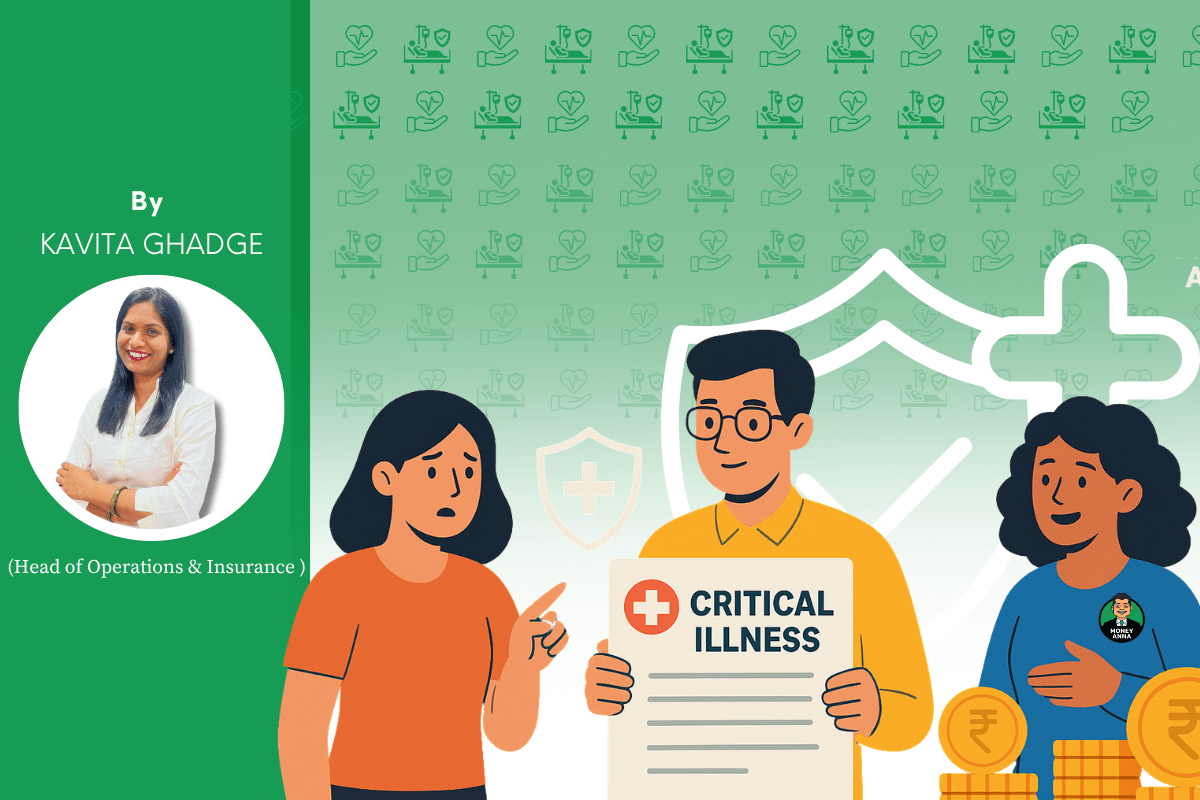What’s in the blog?
This blog breaks down what a Critical Illness Cover really is, why it matters, and who truly needs it. It helps you understand how such a policy works, what to look for before buying one, and how to choose the right cover so that you and your family stay financially secure — even when health throws an unexpected challenge your way.
Table of Contents
Life has controllables and non-controllables. And I’m not saying this as a motivational gyaan, but as a piece of practical advice.
As a finance professional working closely in the insurance space, I live by this principle every day. I regularly interact with clients who face sudden emergencies, and one thing is clear… no matter how much we plan, we can’t control life’s circumstances. But what we can control is how ready we are to deal with them.
We can’t predict a sudden diagnosis, a health emergency, or a long-term treatment that drains us emotionally and financially. But we can definitely prepare for such situations with the right tools. And one of the most powerful among them is a Critical Illness Cover.
Let me guide you through what it really means, who should consider it, and how to choose the right one.
What is a Critical Illness Policy?
Let’s begin by defining it. So, a Critical Illness Policy is a type of health insurance that provides a lump-sum payout if you are diagnosed with a serious or life-threatening disease covered under the policy.
This isn’t like the regular mediclaim policy that reimburses hospital bills. It, instead, pays a fixed amount (sum insured) once your claim is approved.
This lump-sum amount acts like a financial shield, helping you manage not just medical expenses, but also income loss, EMIs, or family needs during recovery. In short, critical illness policy is not simply for getting you through the illness but for ensuring that your life doesn’t collapse outside the hospital while recovering.
What Does Critical Illness Policy Typically Cover?
As we discussed above, a Critical Illness Policy is designed to step in when life takes an unexpected medical turn, unlike regular health insurance, which covers only the ‘medical expenses’.
Critical illness policy covers major, life-threatening illnesses that usually need long-term treatment or surgery and can impact your ability to earn for a while.
Most policies cover conditions like:
- Cancer (of a specified severity)
- Major heart issues, such as a heart attack or heart surgery
- Stroke resulting in lasting symptoms
- Kidney failure requiring dialysis
- Organ or bone marrow transplant
- Multiple sclerosis and a few others
Now, here’s something people often miss… the list of covered illnesses isn’t the same for every insurer.
Some plans cover around 15 illnesses, while others go up to 60 or even more. So, before buying, don’t just go by the premium amount. Take a close look at what you’re actually being protected against.
Because at the end of the day, our aim is to get protection against critical illnesses, not minimise the premium.
Who Should Consider Buying a Critical Illness Policy?
As the policy is named ‘critical illness’, most of us don’t even think of it unless someone really close is diagnosed with a critical illness. Because honestly, who in their regular day thinks that they might get a critical illness?
But, by now, you might have understood that critical illness is not simply about illness, but your financial protection.
So, if you ask me who should consider buying a critical illness policy, my straight answer would be… anyone whose absence from work, even for a few months, can shake up the family’s finances.
You should seriously consider it if:
- You’re the primary earning member, and your family depends on your income.
- You’re paying off home or car loans, because EMIs don’t stop, even when life does.
- There’s a family history of illnesses like cancer or heart disease.
- You’re in your 30s to 50s, when responsibilities are at their peak and health risks quietly begin to rise.
The eligibility for most critical illness plans starts from 18 years and goes up to 65 years, which means the earlier you buy it, the more affordable it’ll be and the longer you’ll be protected.
When you’re in your earning years, your income is your biggest asset. And, a critical illness cover is your way of insuring/protecting that income, not just your health.
Why is it So Important to have a Critical Illness Policy?
Some of you might still think, if you have health insurance, why would you need a critical illness policy? So, let’s understand this with an example.
Suppose person A, who is the earning member of his family, gets a critical illness that hinders his ability to earn for a few months. Now, the health insurance will cover the hospital expenses, but what about the other household expenses? Who will pay the EMIs, children’s fee or even the extra expenses of diet for A?
Regular health plans usually take care of hospital bills, but they don’t compensate for income loss, post-treatment recovery, or the lifestyle changes that come with long-term illnesses. A critical illness cover fills that gap.
Critical illness is that safety net that ensures that while you focus on recovery, your finances don’t take a hit.
Suppose Mr A’s critical illness policy covers ₹20 lakh. Once his claim is approved, he gets the entire amount as a lump sum, and there’s no restriction on where this amount can be used. So now, Mr A can use that amount to manage:
- Medical and treatment costs – ₹8 lakh
- Recovery, diet, and travel expenses – ₹3 lakh
- Income loss during recovery – ₹5 lakh
- Loan EMIs – ₹2 lakh
- Family and household expenses – ₹2 lakh
When health becomes uncertain, financial peace of mind becomes part of the treatment. With a critical illness policy, your focus stays on getting better, not on doing the math.
How Does a Critical Illness Claim Work?
I understand, the biggest concern anyone has about an insurance policy is not buying it, but the claim processing. “What if we get stuck in the claim process?” is a question I always hear from new clients.
The claim process of a critical illness policy is pretty straightforward as long as you follow the timelines and keep your documents ready.
Here’s the process you’ll need to follow:
- Inform your insurer early.
The moment a critical illness is diagnosed, you need to intimate the company within 7 days. Early intimation makes verification smoother and avoids unnecessary delays. - Submit your documents. You’ll need to submit the following claim documents within 30 days of the diagnosis:
- KYC of the insured person
- Medical certificate mentioning the diagnosed illness
- Hospital bills and discharge summary
- Test and investigation reports
- Cancelled cheque for payment processing
- Wait for the settlement.
Once everything is verified, the claim is usually settled within 15 working days, and the lump sum amount is transferred directly to your account.
That’s it. The process is so simple and straightforward. Once your claim is processed successfully, you receive the entire insured amount in one go, giving you the freedom to use it wherever you need it most, whether for treatment, home expenses, or simply to buy time to recover peacefully.
Things to Check Before Buying a Critical Illness Policy
Insurance documents, with their fine print, can be very tricky to understand at times. So, the best approach is always to take the help of a trusted professional who knows the ins and outs of the insurance policies.
And, if you want to do it on your own, be sure that you are well-informed and well-read. Over the years, I’ve seen many people buy policies in a hurry only to realise later that what they thought was covered, actually wasn’t.
So, before you finalise your plan, take a little extra time to check these things carefully:
- How many illnesses are actually covered?
Some policies cover 15 conditions, while others go up to 60 or more. Don’t assume, read the list. - Understand the exclusions.
Every policy has a few conditions it won’t cover. Knowing them in advance helps avoid disappointment later. - Go through the claim process once.
It’s worth understanding what documents will be needed and how much time you’ll have to submit them. - Check the waiting and survival periods.
Some insurers have a 15-day or 30-day survival period after diagnosis, which means that the payout happens only if the insured survives that period. The shorter the waiting period, the better it is in this case. - Review the policy wording.
It may not be exciting reading, but that’s where the details truly lie, especially how each illness is defined. Do not move forward without reviewing the policy wording because you know… the devil lies in the details. - Save your advisor and customer care details.
In emergencies, having a direct contact makes all the difference. You should have your advisor’s and customer care’s numbers saved in your phone so that in the time of an emergency, you do not have to go hunting for the contact numbers in the papers.
We need to be careful at this stage because our goal isn’t just to have a policy but to have a policy that actually works when you need it most — without confusion, hidden clauses, or regret.
How Do You Choose the Right Cover for Your Needs?
One of the most common questions I get asked is “How much cover is enough?” And honestly, there’s no one-size-fits-all answer. It depends on your income, your lifestyle, and how many people depend on you.
But, there’s a thumb-rule I typically share with my clients – Choose a sum insured that’s around 12 times your annual income. This ensures that even if a health emergency affects your ability to work for months, your family’s lifestyle and commitments stay intact.
But that’s just the starting point. There are a few other things worth considering:
- If your spouse is not working, consider taking an additional cover worth 50% of your income in their name.
- Look for a policy that covers a wider range of illnesses, not just the basic ones. A broader list ensures better protection as medical conditions evolve.
At the end of the day, the right policy isn’t just about the amount; it’s about how completely it protects your life stage and responsibilities.
My Take
I’ve seen families crumble under the weight of sudden expenses, and I’ve seen families who, thanks to a well-planned cover, could handle the same crisis with dignity and calm. The only thing that creates this difference is preparedness.
So while we can’t control what tomorrow brings, we can definitely control how ready we are to face it. And that readiness starts with a single decision. Once you decide to protect your health, your income, and your peace of mind, you can reach out to us for any guidance or support you need.
Frequently asked questions (FAQ)
Not exactly. A health insurance policy reimburses your hospital and treatment expenses, while a critical illness cover gives you a lump-sum payout when you’re diagnosed with a covered illness. You can use this money for anything, treatment, EMIs, or daily living expenses, not just hospital bills.
Absolutely, you can. In fact, that’s the smart thing to do. A health plan covers your medical costs, while a critical illness plan ensures income continuity and financial flexibility during recovery. The two complement each other, not replace one another.
Most insurers have specific waiting periods or exclusions for pre-existing illnesses like diabetes, hypertension, or a cancer history. However, if you disclose your medical history honestly, you can still get covered for other critical conditions. Always check the policy wording carefully.
Once the claim is approved, the insurer pays the entire insured amount at once. Whether your recovery costs less or more doesn’t affect the payout — it’s yours to use as you wish. There’s no need to return any portion of it.
Yes. Premiums paid towards a critical illness policy qualify for tax deductions under Section 80D of the Income Tax Act, just like regular health insurance premiums.




